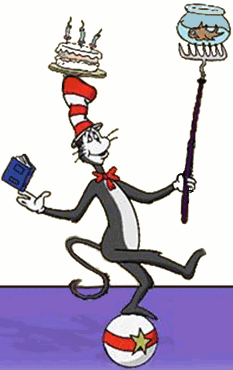Cat In The Hat Balancing On Ball
Have you ever seen the famous Cat in the Hat balancing on a ball? It's a classic children's book scene that has captured the hearts and imaginations of generations. But have you ever wondered how he does it? How does the Cat in the Hat manage to balance on a ball, and what can we learn from his balancing act?
Understanding the Pain Points
Many of us have experienced difficulties in trying to balance, whether it's on a tightrope or a balance beam. Balancing is a skill that requires practice, patience, and a good deal of focus. It can be frustrating to fail and fall off repeatedly, which can be discouraging. The same goes for trying to balance on a ball like the Cat in the Hat.
Answering the Target
The key to balancing on a ball is to focus on your core muscles. These muscles are responsible for maintaining your body's balance and stability. By strengthening these muscles, you can improve your overall balance and make it easier to balance on a ball or other unstable surface.
Summarizing the Main Points
In summary, balancing on a ball like the Cat in the Hat requires a strong focus on core muscles and stability. By practicing this skill regularly, you can improve your balance and stability, which can benefit you in a variety of other physical activities.
The Benefits of Balancing on a Ball
When it comes to improving balance, there are few tools more effective than a balance ball. Not only can it help strengthen your core, but it can also help improve your flexibility and coordination. It's a fun and challenging way to stay active and healthy.
My personal experience with balancing on a ball has been both challenging and rewarding. As someone who has always struggled with balance, I was hesitant to try it at first. But with patience and practice, I was able to improve my balance and coordination, which has helped me in many other areas of my life.
The Science behind Balancing on a Ball
When it comes to the science of balancing on a ball, there are a few key factors at play. For one, the ball is an unstable surface, which means that your body has to constantly adjust and shift in order to maintain its balance. This requires a strong focus on your core muscles, which are responsible for keeping your body stable and upright.
Additionally, balancing on a ball requires a certain level of proprioception, which is your body's awareness of its position in space. This helps your body make the necessary adjustments to maintain balance and stability. By improving your proprioception, you can improve your overall balance and coordination, which can benefit you in a variety of other physical activities.
Going Deeper into Balancing on a Ball
To further improve your balancing skills, there are a few exercises you can try. One is to practice balancing on one leg, which can help strengthen your core and improve your overall balance. Another is to practice balancing on a stability ball or other unstable surface, which can help improve your proprioception and strengthen your core muscles.
Tips for Balancing on a Ball
When trying to balance on a ball, there are a few tips to keep in mind. First, make sure the ball is properly inflated and the correct size for your body. Second, start by practicing near a wall or other sturdy object that you can use for support. Finally, don't be discouraged if you fall off at first. Balancing on a ball takes time and practice, but with patience and dedication, you can improve your skills and enjoy the many benefits of this fun and challenging activity.
Question and Answer
Q: Can balancing on a ball help with other physical activities?
A: Yes, improving your balance and coordination can benefit you in a variety of other physical activities, such as sports, dance, and yoga.
Q: What size ball should I use?
A: The size of the ball should correspond to your height. A general rule of thumb is to choose a ball that is 55-65 cm if you are between 5' and 5'9" in height.
Q: Is it safe to balance on a ball?
A: Yes, as long as you use the proper equipment and take necessary precautions, balancing on a ball is a safe and effective way to improve your balance and coordination.
Q: How often should I practice balancing on a ball?
A: It is recommended to practice for at least 10-15 minutes per day, several times per week, in order to see improvement in your balancing skills.
Conclusion
Balancing on a ball like the Cat in the Hat may seem like a daunting task, but with patience and practice, anyone can improve their skills. By focusing on your core muscles and proprioception, you can improve your overall balance and coordination, which can benefit you in a variety of other physical activities. So put on your hat and start balancing!
Gallery
Juggling Cat In The Hat Inspired By Dr. Seuss: 24" X 48" | Dr Seuss

Photo Credit by: bing.com / juggling hat cat dr seuss etsy inspired
Solved The Cat-In-The-Hat Is Balancing On A Small Massless | Chegg.com

Photo Credit by: bing.com / balancing
Balancing Like The Cat In The Hat: A Mini-Lesson On The Center Of

Photo Credit by: bing.com / hat cat balancing gravity center lesson mini
Recentnewsb

Photo Credit by: bing.com / balancing virtually
The Cat In The Hat Engineering Challenge - KidMinds
Photo Credit by: bing.com / challenge cat kidminds engineering hat